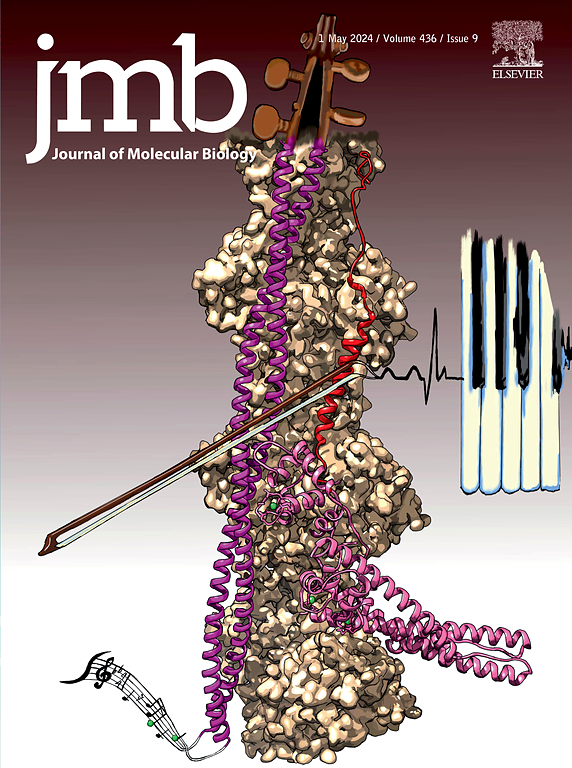Harnessing Allostery to Modulate Protein–Protein Interactions: From Function to Therapeutic Innovations
IF 4.5
2区 生物学
Q1 BIOCHEMISTRY & MOLECULAR BIOLOGY
引用次数: 0
Abstract
Protein-protein interactions (PPIs) are ubiquitous mediators of cellular functions, and their dysregulation is central to numerous pathological conditions. Traditional drug discovery strategies targeting PPIs directly have faced considerable obstacles due to their extensive, flat, and dynamic interfaces, deemed conventionally “undruggable”. Allosteric regulation offers an alternative route, allowing modulation of these critical interactions through spatially distinct regulatory sites that can dynamically alter protein function without direct interference at the interface. Recent advances in computational methodologies, particularly enhanced molecular dynamics simulations and machine learning approaches, have significantly expanded our ability to identify and characterize cryptic allosteric sites and pathways. This perspective provides a comprehensive analysis of the evolving understanding of allosteric mechanisms in PPIs, highlights recent successes in computational identification and targeting of allosteric modulators, and outlines the challenges and opportunities in translating these insights into therapeutic strategies. Ultimately, this approach heralds a transformative potential in therapeutic interventions targeting complex biological networks.

利用变构调节蛋白质-蛋白质相互作用:从功能到治疗创新。
蛋白-蛋白相互作用(PPIs)是普遍存在的细胞功能介质,其失调是许多病理条件的核心。传统的药物发现策略直接针对PPIs,由于其广泛、平坦和动态的界面,传统上被认为是“不可药物的”,因此面临着相当大的障碍。变构调节提供了另一种途径,允许通过空间上不同的调节位点来调节这些关键的相互作用,这些位点可以动态地改变蛋白质的功能,而不会在界面上产生直接干扰。计算方法的最新进展,特别是增强的分子动力学模拟和机器学习方法,极大地扩展了我们识别和表征隐变构位点和途径的能力。这一观点提供了对PPIs中变构机制不断发展的理解的全面分析,强调了最近在计算识别和变构调节剂靶向方面的成功,并概述了将这些见解转化为治疗策略的挑战和机遇。最终,这种方法预示着针对复杂生物网络的治疗干预的变革潜力。
本文章由计算机程序翻译,如有差异,请以英文原文为准。
求助全文
约1分钟内获得全文
求助全文
来源期刊

Journal of Molecular Biology
生物-生化与分子生物学
CiteScore
11.30
自引率
1.80%
发文量
412
审稿时长
28 days
期刊介绍:
Journal of Molecular Biology (JMB) provides high quality, comprehensive and broad coverage in all areas of molecular biology. The journal publishes original scientific research papers that provide mechanistic and functional insights and report a significant advance to the field. The journal encourages the submission of multidisciplinary studies that use complementary experimental and computational approaches to address challenging biological questions.
Research areas include but are not limited to: Biomolecular interactions, signaling networks, systems biology; Cell cycle, cell growth, cell differentiation; Cell death, autophagy; Cell signaling and regulation; Chemical biology; Computational biology, in combination with experimental studies; DNA replication, repair, and recombination; Development, regenerative biology, mechanistic and functional studies of stem cells; Epigenetics, chromatin structure and function; Gene expression; Membrane processes, cell surface proteins and cell-cell interactions; Methodological advances, both experimental and theoretical, including databases; Microbiology, virology, and interactions with the host or environment; Microbiota mechanistic and functional studies; Nuclear organization; Post-translational modifications, proteomics; Processing and function of biologically important macromolecules and complexes; Molecular basis of disease; RNA processing, structure and functions of non-coding RNAs, transcription; Sorting, spatiotemporal organization, trafficking; Structural biology; Synthetic biology; Translation, protein folding, chaperones, protein degradation and quality control.
 求助内容:
求助内容: 应助结果提醒方式:
应助结果提醒方式:


